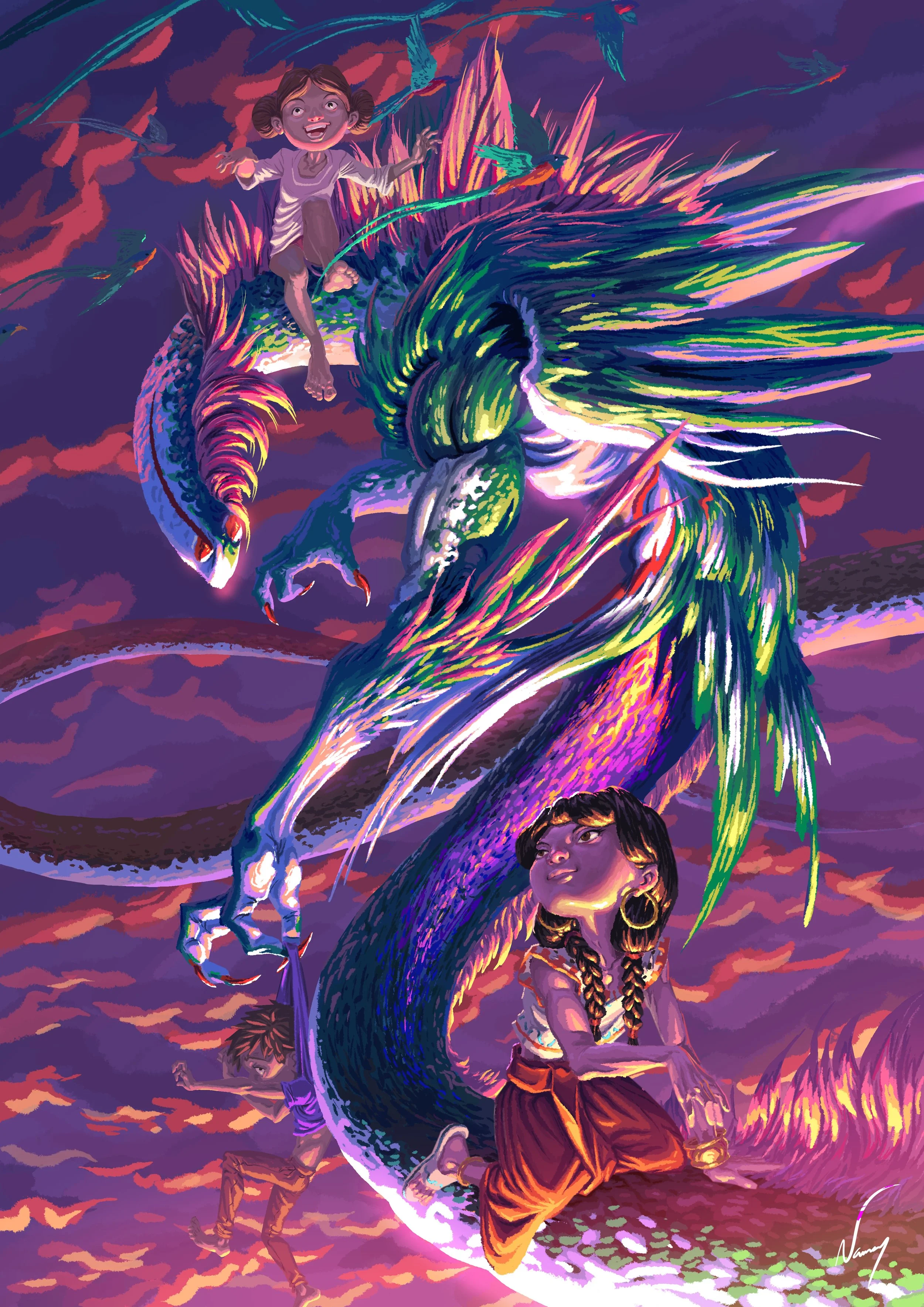LEGENDS
Folklore, tales, divinities or legends, all over the world there are thousands of figures that we’ve became acquainted with be it through stories we used to hear when we were kids, books of science fiction or fantasy that we read, games we’ve played or maybe even an event we’ve experienced. This project is where I let myself imagine these compelling narratives of characters (and places) which give us a sense of wonder and meaning to our world.

Marina and Quetzalcoatl
Quetzalcoatl is the Aztec god of winds, patron of priests, and inventor of calendars and books. They were known as the Feathered Serpent and played an integral role in the creation of the universe and humanity. Quetzalcoatl was often depicted as a trickster god and in this picture you can see Marina (in the foreground) looking at them after she summoned the deity to give a lesson to her brother Lucas (in the background held by Quetzalcoatl’s fingers), as he was doubting that the god’s magic was real.
Serena, their sister, is seen mindlessly playing with the birds that have the same name as the god, who stares at Marina, wondering if it was a valid reason to summon them, although not completely disagreeing of it giving the fact that Lucas loves to prank other people and now got his turn.
Òsún
The Yoruba Orishá (deity) of Rivers is also is the goddess of divinity, femininity, beauty, and love. She is the youngest Orishá and also considered one of the most powerful, tipically associated with water, fertility and sensuality. She is often depicted admiring her beauty in a mirror, showing her devotees there’s power is self-love and self-confidence.
Osun was part of the 17 Orishás and the only female one sent by Olodumaré, the Supreme god, to multiply and fruitify the earth.
However after reaching the Earth, Òsún was presumed useless by the other Orishás who thought it was a man’s job to revive humanity and she was not able, for being a woman. After many unsuccessful attempts they went back to the Supreme god to find a solution, when Olodumare told them that the solution had gone with them to Earth.
Realising it was Òsún he was talking about they searched for her and asked for her help. That is when Òsún brought the sweet and powerful waters, creating humanity and bringing life back to earth with of the other species.
Sobek
Benevolent yet unpredictable, Sobek it the Egyptian god of the the waters and the fertility of the soil. He was known as “Lord of the Waters” and also patron of the military for his power and prowess. He took the characteristics of the crocodiles of the the Nile, making him loved but also feared for his ferocity.
In this piece he is depicted more as a benevolent force and as a protector of children, because a nation’s power is only true when it allows its citizens to grow in wonder for life and respect for the afterlife.
Raijin and Shun
Shun is a young and talented Japanese drummer who has learned to summon the powerful thunder god Raijin while playing electrifying beats. From a young age he would get so immersed in playing the drums that he says that at a certain point he didn’t feel like he was the one actually playing. Later he found out that the thunder god took a liking to him for his steady and disciplined and almost ritualized practice with passion for rock music, deciding to aid him in creating music that would connect people and charge them with soulful energy.
Karen and the Triple Goddesses
Yes she’s a Karen. Studying to become a fully fledged sorceress, which makes her quite dangerous.
Working part time in the city’s library, Karen uses her natural privilege to entice men into submission. They’re not usually bright so they can’t see that she’s often accompanied by the Triple goddesses of the Moon, who tell her everything she needs to know about seizing power from patriarchy.
The only question that is still a mystery is for what is Karen building so much knowledge, knowing that it means power?
João and Oxalá
As the Orishá related to the creation on the world, Oxalá is here represented as a Crystal which reflects every consciousness that is aware of them back. Oxalá means light. In the Umbanda tradition and their colors are usually white, mixed with white in the Candomblé religion. The Orishá is revered as the greatest and most respected one in the African pantheon. They symbolize peace and is the father in the religions African tradition.
Oxalá means white light and here you can see João who is a kid initiated in Umbanda who in a very early age showed a great talent in healing the most varied types of diseases. He would ask for the diseased person to write on a piece o paper their wishes for the wellbeing of their family or closest circle and give them to the bright Orishá. With this, the Orishá would give a task to each person whose name was written in the paper.
Only then when the task was completed by all of the relatives or close people, they would start working with João on collecting the items needed for the healing ritual.





